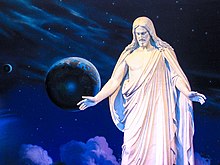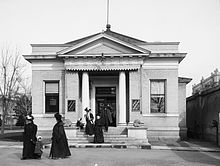Temple Square
Temple Square | |
 Temple Square, approx 1898–1905, showing the Salt Lake Temple, Salt Lake Tabernacle and Salt Lake Assembly Hall | |
 | |
| Location | Salt Lake City, Utah |
|---|---|
| Coordinates | 40°46′13″N 111°53′33″W / 40.77041°N 111.89246°WCoordinates: 40°46′13″N 111°53′33″W / 40.77041°N 111.89246°W |
| Area | 10 acres (4.0 ha) |
| Built | 1853 |
| NRHP reference No. | 66000738[1] |
| Significant dates | |
| Added to NRHP | October 15, 1966 |
| Designated NHLD | January 29, 1964[2] |
Temple Square is a 10-acre (4.0 ha) complex, owned by The Church of Jesus Christ of Latter-day Saints (LDS Church), in the center of Salt Lake City, Utah. The usage of the name has gradually changed to include several other church facilities that are immediately adjacent to Temple Square. Contained within Temple Square are the Salt Lake Temple, Salt Lake Tabernacle, Salt Lake Assembly Hall, the Seagull Monument, and two visitors' centers. The square was designated a National Historic Landmark District in 1964, recognizing the Mormon achievement in the settlement of Utah.[3]
History[]


In 1847, when Mormon pioneers arrived in the Salt Lake Valley, president Brigham Young selected a plot of the desert ground, initially referred to as Temple Block,[4] and proclaimed, "Here we will build a temple to our God."[5] When the city was surveyed, the block enclosing that location was designated for the temple, and became known as Temple Square. Temple Square is surrounded by a 15-foot wall that was built shortly after the block was so designated.
The square also became the headquarters of the LDS Church. Other buildings were built on the plot, including a tabernacle (prior to the one occupying Temple Square today) and Endowment House, both of which were later torn down. The Salt Lake Tabernacle, home of The Tabernacle Choir at Temple Square, was built in 1867 to accommodate the church's general conferences, with a seating capacity of 8,000. Another church building, the Salt Lake Assembly Hall, was later built with a seating capacity of 2,000.
As the church has grown, its headquarters have expanded into the surrounding area. In 1917, an administration building was built on the block east of the temple and in 1972, the twenty-eight story LDS Church Office Building, which was, for many years, the tallest building in the state of Utah. The Hotel Utah, another building on this block, was remodeled in 1995 as additional office space and a large film theater and renamed the Joseph Smith Memorial Building. In 2000, the church purchased the section of Main Street between this block and Temple Square and connected the two blocks with a plaza called the Main Street Plaza. In 2000, the church completed a new, 21,000 seat Conference Center on the block north of Temple Square.
In 2020, many of the buildings on and around Temple Square were closed due to the COVID-19 pandemic, and the 4-year renovation project.[6][7]
Modern usage[]
Tourism[]
Attracting 3 million to 5 million visitors a year, Temple Square is the most popular tourist attraction in Utah, bringing in more visitors than the Grand Canyon or Yellowstone National Park. By comparison, Utah's five National Parks—Zion, Bryce Canyon, Capitol Reef, Canyonlands, and Arches—had a combined total of 5.3 million visitors in 2005.[8]
General Conference[]
Lighting[]
The grounds, as well as the Gardens at Temple Square, often host concerts and other events. During the Christmas holiday season, approximately 100,000 Christmas lights sparkle from trees and shrubs around Temple Square each evening until 10 pm. The lighting of Temple Square is a popular event, usually attended by more than 10,000 people.[9]
Other uses[]
The multiple gates to Temple Square are popular places for critics of the LDS Church—mainly former members and activist evangelical ministers—to picket and hand out tracts and literature critical of the church. They are also well-known locations for street musicians to perform, especially during the holiday season.
Street directions[]
Temple Square serves as the center point for all street addresses in Salt Lake City. The streets in Salt Lake follow a grid pattern which deviate out from the southeast corner of Temple Square.
Sites[]
Salt Lake Temple[]
The Salt Lake Temple is the largest and best-known of the LDS Church's operating temples.[10] It is the sixth temple built by the church overall, and the fourth operating temple built following the Mormon exodus from Nauvoo, Illinois.
North and South Visitors' Centers[]

Today, Temple Square features two visitors' centers, called the North Visitors' Center and the South Visitors' Center. The North Visitors' Center was built first and features a replica of the Christus, a statue of Jesus Christ by Danish sculptor Bertel Thorvaldsen. The Christus is in a domed room with large windows, painted with clouds, stars, planets, and other heavenly bodies. The visitors' centers and grounds are staffed by full-time sister missionaries[11] and senior missionary couples exclusively; no single male missionaries are called to serve on Temple Square. The sister missionaries serving on Temple Square are from around the world, speaking enough languages to cater to the majority of visitors. Beginning with the 2002 Winter Olympic Games in Salt Lake City, the sister missionaries have been wearing tags with the national flags of their home country along with their missionary name tags.
On April 19, 2019, church leaders announced that the South Visitors' Center will be demolished as part of a massive renovation project that will begin December 29, 2019. Two smaller visitors' pavilions will take its place.[12]


Conference and assembly buildings[]
There are three large assembly buildings housed on Temple Square. The smallest of the three is the Salt Lake Assembly Hall, which seats approximately 2,000 and is on the southwest corner of Temple Square. The Assembly Hall is a Victorian Gothic congregation hall, with a cruciform layout of the interior that is complemented by Stars of David circumscribed high above each entrance, which symbolize the gathering of the Twelve Tribes of Israel. Construction of the hall began on August 11, 1877, and was completed in 1882.[13] It is just south of the Salt Lake Tabernacle and across from the South Visitor Center near the South Gate. Upon entering Temple Square from the south, the Assembly Hall can be seen to the left (west). The Assembly Hall hosts occasional free weekend music concerts and is filled as overflow for the church's twice-a-year general conferences.
The second structure is the Salt Lake Tabernacle, home of the Mormon Tabernacle Choir and Orchestra at Temple Square. The Tabernacle was built between 1864 and 1867 with an overall seating capacity of 8,000, including the choir area and gallery. In March 2007, the Tabernacle was rededicated after extensive renovations and restorations were completed. Spacing between the pews was substantially increased, resulting in a reduced overall seating capacity. The Tabernacle was rededicated at the Saturday afternoon session of the church's 177th Annual General Conference. In addition to housing the choir, the Tabernacle is also used for other religious and cultural events.
The largest and most recently built assembly building is the LDS Conference Center. With a capacity of over 21,000, it is used primarily for the LDS Church's general conferences as well as for concerts and other cultural events. The Conference Center was completed in 2000. Attached on the northwest corner of the Conference Center is the Conference Center Theater, an 850-seat theater for dramatic presentations, such as Savior of the World, as well as concerts and other events.[14]
Museums and libraries[]
Family History Library[]
On the block west of Temple Square, the Family History Library is the largest genealogical library in the world and is open to the general public at no charge.[15] The library holds genealogical records for over 110 countries, territories, and possessions. Its collections include over 2.4 million rolls of microfilmed genealogical records; 742,000 microfiche; 310,000 books, serials, and other formats; 4,500 periodicals; and 700 electronic resources.
Church History Museum[]
On the block west of Temple Square adjacent to the Family History Library, the Church History Museum houses collections of Latter-day Saint art and artifacts.[16] The Museum houses permanent exhibits as well as playing host to temporary exhibits throughout the year. Past exhibits have included the 100th anniversary of the Boy Scouts of America, featuring 23 paintings by Norman Rockwell; displays and artwork from artist Arnold Friberg; and themed historical displays depicting church events.[17]

Church History Library[]
On the block northeast of Temple Square and east of the LDS Conference Center is the Church History Library, where the historical records of the LDS Church are stored. The Library is free to patrons, who can come use a large collection of books, manuscripts, and photographs. Senior missionaries provide tours of the public areas of the Library. Patrons can also view a video explaining the mission and purpose of the Library.
See also[]
- List of National Historic Landmarks in Utah
- National Register of Historic Places listings in Salt Lake City
- Nauvoo Bell
References[]
- ^ "National Register Information System". National Register of Historic Places. National Park Service. January 23, 2007.
- ^ "Temple Square". National Historic Landmark summary listing. National Park Service. Archived from the original on 2007-10-18. Retrieved 2008-07-12.
- ^ "NHL nomination for Temple Square". National Park Service. Retrieved 2018-03-16.
- ^ https://rsc.byu.edu/tabernacle-old-wonderful-friend/buildings-temple-block-preceding-tabernacle
- ^ Quoted in Gordon B. Hinckley, "The Salt Lake Temple", Ensign, March 1993, p. 2.
- ^ Harkins, Paighten. "LDS Church closes Temple Square, other downtown attractions, because of coronavirus", The Salt Lake Tribune, 14 March 2020. Retrieved on 18 March 2020.
- ^ "Plans Unveiled for Salt Lake Temple Renovation". newsroom.churchofjesuschrist.org. 2019-04-19. Retrieved 2020-08-06.
- ^ Graham, Jim (2006-05-21). "Temple Square still top tourist attraction in Utah". Daily Herald. Retrieved 2006-12-14.
- ^ Michael De Groote, "Decades of downtown S.L. music and lights", Deseret News, December 12, 2010.
- ^ There are 168 dedicated temples (160 currently operating; and 8 previously dedicated, but closed for renovation), 41 under construction, and 43 announced (not yet under construction), for a total of 252.
- ^ Law, Kristina (2006). "Sister Missionaries". Archived from the original on 2007-04-29. Retrieved 2006-12-14.
- ^ "Plans Unveiled for Salt Lake Temple Renovation". Mormon Newsroom. 2019-04-19. Retrieved 2019-04-21.
- ^ Assembly Hall.
- ^ Conference Center.
- ^ AAG International Research. "AAG International Research". AAG International Research. Retrieved 2009-10-31.
- ^ McFall, Michael. "A 'tour' of the new Church History Museum before it reopens", The Salt Lake Tribune, 3 October 2014. Retrieved on 16 March 2020.
- ^ Burke, Leann. "Church History Museum exhibits celebrate 100 years of Scouting", The Salt Lake Tribune, 18 July 2013. Retrieved on 16 March 2020.
Further reading[]
- Hamilton, C. Mark (1994), "Temple Square", in Powell, Allan Kent (ed.), Utah History Encyclopedia, Salt Lake City, Utah: University of Utah Press, ISBN 0-87480-425-6, OCLC 30473917, archived from the original on 2013-04-11
- Springer, Carly M. (May 23, 2014), "40 Things You Didn't Know about Temple Square", LDS Living, Deseret Books
- KSL News: LDS Main Street Plaza Controversy
External links[]
 Media related to Temple Square at Wikimedia Commons
Media related to Temple Square at Wikimedia Commons- Official website – The Church of Jesus Christ of Latter-day Saints
- Official Site – Temple Square
- Panoramic View of Temple Square at Sunset
- Historic American Engineering Record (HAER) No. UT-36, "Great Salt Lake Base & Meridian, Temple Square, Salt Lake City, Salt Lake County, UT", 1 photo, 2 data pages, 1 photo caption page
- Temple Square
- 1853 establishments in Utah Territory
- Historic districts on the National Register of Historic Places in Utah
- National Historic Landmarks in Utah
- Properties of religious function on the National Register of Historic Places in Utah
- Significant places in Mormonism
- Squares and plazas in Salt Lake City
- Historic American Engineering Record in Utah
- National Register of Historic Places in Salt Lake City


